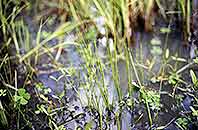Isoetes aequinoctialis Welw. ex A. Braun
Synonyms |
Calamaria aequinoctialis (Welw. ex A.Braun) Kuntze |
|---|---|
Common name |
|
Description |
Pseudo-corm 3-lobed, 5-10 mm in diameter; bud scales brownish, thin, papery, often absent. Leaves 10-20, pale green, stiff, 40-350 mm × 1-1.5 mm, apex abruptly pointed, triangular in cross-section, initially with broad membranous margin about 3 mm wide above the sporangia. Ligule often 3-lobed, deltate, tapering to a point. Velum covering lower half of the sporangia or reduced to a marginal ring less than 1-2 mm wide. Sporangia 3-7 × 1.5-3 mm. Megaspores of two sizes, about 0.5 and 0.35 mm, greyish when dry, upper face finely granular or minutely verrucose, lower with widely spaced papillae or granules. Micropsores scabrate. |
Notes | I. alstonii is distinguished from I. aequinoctialis by its 2-lobed pseudo-corm. I. schweinfurthii is separated from I. aequinoctialis by lacking a velum. |
Derivation | aequinoctialis: of the equinox, a term used for flowers that open or close at stated hours. Obscure reference, it may refer to the time of year when this plant was first collected in Angola by F.M.J. Welwitsch. |
Habitat | In perennial streams and seasonally waterlogged sites overlying granite sheetrock, boggy grassland. |
Distribution worldwide | See African distribution. |
Distribution in Africa |
Angola, Ethiopia, Ghana, Mali, Namibia, South Africa, Tanzania , Zambia, Zimbabwe. |
Growth form |
Terrestrial. |
Literature |
|

